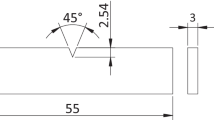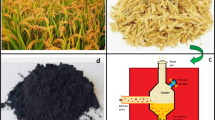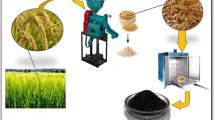Abstract
The biocomposites were produced by layering sequence of pure sisal fiber mat (SSSS), pure hemp fiber mat (HHHH), and their hybrid mats and then subjected to accelerated weathering conditions. The composite specimens were conditioned under ultraviolet (UV) light and water spray simultaneously for 2222 h, which corresponds to approximately 1 year of the outdoor conditions. Mechanical properties and thermogravimetric analysis (TGA) of the weathered composites were compared to the dry or unweathered composites. Chemical changes to the bio-based epoxy matrix and natural fiber induced by photodegradation were evident as a reduction in intensity and broadening of characteristic peaks from the Fourier Transform Infrared spectroscopy (FTIR) analysis. Tensile strength and flexural strength of the weathered HSSH and HSHS declined by 7%, 13%, 25%, and 26%, respectively. Degradation effects of weathering were also visible from the lower residue of the weathered composite specimens from the thermogravimetric analysis. Despite the slight drop in impact strength, all the weathered composite specimens had good impact resistance. Furthermore, the hybrid composites exposed to weathering had nearly equivalent impact strength compared to the pure sisal and hemp-based composites under the impact load. Based on this observation, sisal/hemp fiber bio-epoxy based hybrid composites are recommended for the outdoor structural applications requiring impact resistance.










Similar content being viewed by others
References
Satyanarayana KG, Arizaga GGC, Wypych F (2009) Biodegradable composites based on lignocellulosic fibers—an overview. Prog Polym Sci 34:982–1021
Siakeng R, Jawaid M, Asim M, Siengchin S (2020) Accelerated weathering and soil burial effect on biodegradability, colour and textureof coir/pineapple leaf fibres/PLA biocomposites. Polymers 12:458
Krishnasamy S, Muthukumar C, Nagarajan R et al (2019) Effect of fibre loading and Ca(OH)2 treatment on thermal, mechanical, and physical properties of pineapple leaf fibre/polyester reinforced composites. Mater Res Express 6:085545. https://doi.org/10.1088/2053-1591/ab2702
Chandrasekar M, Shahroze RM, Ishak MR et al (2019) Flax and sugar palm reinforced epoxy composites: effect of hybridization on physical, mechanical, morphological and dynamic mechanical properties. Mater Res Express 6(10):105331
Martin R, Campion R (1996) The effects of ageing: on fibre reinforced plastics. Mater World 4:200–202
Islam MS, Pickering KL, Foreman NJ (2010) Influence of accelerated ageing on the physico-mechanical properties of alkali-treated industrial hemp fibre reinforced poly (lactic acid)(PLA) composites. Polym Degrad Stab 95:59–65
Stark NM, Matuana LM (2003) Ultraviolet weathering of photostabilized wood-flour-filled high-density polyethylene composites. J Appl Polym Sci 90:2609–2617
Matuana LM, Kamdem DP, Zhang J (2001) Photoaging and stabilization of rigid PVC/wood-fiber composites. J Appl Polym Sci 80:1943–1950
Azwa ZN, Yousif BF, Manalo AC, Karunasena W (2013) A review on the degradability of polymeric composites based on natural fibres. Mater Des 47:424–442. https://doi.org/10.1016/j.matdes.2012.11.025
Barnes DKA, Galgani F, Thompson RC, Barlaz M (2009) Accumulation and fragmentation of plastic debris in global environments. Philos Trans R Soc B 364:1985–1998
Hopewell J, Dvorak R, Kosior E (2009) Plastics recycling: challenges and opportunities. Philos Trans R Soc B 364:2115–2126
Shah AA, Hasan F, Hameed A, Ahmed S (2008) Biological degradation of plastics: a comprehensive review. Biotechnol Adv 26:246–265
Batista KC, Silva DAK, Coelho LAF et al (2010) Soil biodegradation of PHBV/peach palm particles biocomposites. J Polym Environ 18:346–354
Yorseng K, Rangappa SM, Pulikkalparambil H et al (2020) Accelerated weathering studies of kenaf/sisal fiber fabric reinforced fully biobased hybrid bioepoxy composites for semi-structural applications: Morphology, thermo-mechanical, water absorption behavior and surface hydrophobicity. Constr Build Mater 235:117464. https://doi.org/10.1016/j.conbuildmat.2019.117464
Spiridon I, Darie RN, Kangas H (2016) Influence of fiber modifications on PLA/fiber composites. Behavior to accelerated weathering. Composites Part B 92:19–27. https://doi.org/10.1016/j.compositesb.2016.02.032
Dayo AQ, Babar AA, Qin Q, rui, et al (2020) Effects of accelerated weathering on the mechanical properties of hemp fibre/polybenzoxazine based green composites. Composites Part A. https://doi.org/10.1016/j.compositesa.2019.105653
Stark NM, Matuana LM, Clemons CM (2004) Effect of processing method on surface and weathering characteristics of wood-flour/HDPE composites. J Appl Polym Sci 93:1021–1030. https://doi.org/10.1002/app.20529
Abu-Sharkh BF, Hamid H (2004) Degradation study of date palm fibre/polypropylene composites in natural and artificial weathering: Mechanical and thermal analysis. Polym Degrad Stab 85:967–973. https://doi.org/10.1016/j.polymdegradstab.2003.10.022
Chee SS, Jawaid M, Sultan MTH et al (2019) Accelerated weathering and soil burial effects on colour, biodegradability and thermal properties of bamboo/kenaf/epoxy hybrid composites. Polym Test 79:106054. https://doi.org/10.1016/j.polymertesting.2019.106054
Joseph K, James B, Thomas S, De Carvalho LH (1999) A review on sisal fiber reinforced. Polymer. 3:367–379
Shahzad A (2012) Hemp fiber and its composites—a review. J Compos Mater 46:973–986. https://doi.org/10.1177/0021998311413623
Li Y, Mai Y-W, Ye L (2000) Sisal fibre and its composites: a review of recent developments. Compos Sci Technol 60:2037–2055. https://doi.org/10.1016/S0266-3538(00)00101-9
Senthilkumar K, Saba N, Rajini N et al (2018) Mechanical properties evaluation of sisal fibre reinforced polymer composites: a review. Constr Build Mater 174:713–729
Thiagamani SMK, Krishnasamy S, Muthukumar C et al (2019) Investigation into mechanical, absorption and swelling behaviour of hemp/sisal fibre reinforced bioepoxy hybrid composites: effects of stacking sequences. Int J Biol Macromol 140:637–646. https://doi.org/10.1016/j.ijbiomac.2019.08.166
ASTM G155–13. Standard practice for operating Xenon Arc light apparatus for exposure of non-metallic materials, ASTM International, West Conshohocken
ASTM (2014) Astm D3039/D3039M. Annu B ASTM Stand. https://doi.org/10.1520/D3039
ASTM (2017) D790—flexural properties of unreinforced and reinforced plastics and electrical insulating materials. ASTM Stand. https://doi.org/10.1520/D0790-17.2
American society for testing and materials (2018) ASTM D256: standard test methods for determining the Izod pendulum impact resistance of plastics. 10:1–20. https://doi.org/10.1520/D0256-10R18.N
Manaia JP, Manaia AT, Rodriges L (2019) Industrial hemp fibers: an overview. Fibers 7:106. https://doi.org/10.3390/fib7120106
Sgriccia N, Hawley MC, Misra M (2008) Characterization of natural fiber surfaces and natural fiber composites. Composites Part A 39:1632–1637
Pulikkalparambil H, Rangappa SM, Krishnasamy S et al (2020) Accelerated weathering studies of bioepoxy/ionic liquid blends: influence on physical, thermo-mechanical, morphology and surface properties. Mater Res Express. https://doi.org/10.1088/2053-1591/ab6e87
Islam MS, Pickering KL, Foreman NJ (2011) The effect of accelerated weathering on the mechanical properties of alkali treated hemp fibre/epoxy composites. J Adhes Sci Technol 25:1947–1959
Awad SA, Fellows CM, Saeed Mahini S (2018) A comparative study of accelerated weathering of epoxy resins based on DGEBA and HDGEBA. J Polym Res. https://doi.org/10.1007/s10965-018-1489-3
Krishnasamy S, Thiagamani SMK, Muthukumar C et al (2019) Effects of stacking sequences on static, dynamic mechanical and thermal properties of completely biodegradable green epoxy hybrid composites. Mater Res Express 6:105351
Chen Y, Davalos JF, Ray I, Kim H-Y (2007) Accelerated aging tests for evaluations of durability performance of FRP reinforcing bars for concrete structures. Compos Struct 78:101–111
Joseph PV, Rabello MS, Mattoso LHC et al (2002) Environmental effects on the degradation behaviour of sisal fibre reinforced polypropylene composites. Compos Sci Technol 62:1357–1372
Ashori A, Sheshmani S (2010) Hybrid composites made from recycled materials: moisture absorption and thickness swelling behavior. Bioresour Technol. https://doi.org/10.1016/j.biortech.2010.01.060
Wang W, Sain M, Cooper PA (2006) Study of moisture absorption in natural fiber plastic composites. Compos Sci Technol 66:379–386. https://doi.org/10.1016/j.compscitech.2005.07.027
Idicula M, Joseph K, Thomas S (2010) Mechanical performance of short banana/sisal hybrid fiber reinforced polyester composites. J Reinf Plast Compos 29:12–29. https://doi.org/10.1177/0731684408095033
Idicula M, Neelakantan NR, Oommen Z et al (2004) A study of the mechanical properties of randomly oriented short banana and sisal hybrid fiber reinforced polyester composites. Scanning. https://doi.org/10.1002/app.21636
Aji IS, Zainudin ES, Abdan K et al (2013) Mechanical properties and water absorption behavior of hybridized kenaf/pineapple leaf fibre-reinforced high-density polyethylene composite. J Compos Mater 47:979–990. https://doi.org/10.1177/0021998312444147
De Albuquerque AC, Joseph K, Hecker De Carvalho L, D’Almeida JRM (2000) Effect of wettability and ageing conditions on the physical and mechanical properties of uniaxially oriented jute-roving-reinforced polyester composites. Compos Sci Technol 60:833–844
Dubey MK, Pang S, Walker J (2010) Color and dimensional stability of oil heat-treated radiata pinewood after accelerated UV weathering. For Prod J 60:453–459
Khalil HPSA, Firoozian P, Bakare IO et al (2010) Exploring biomass based carbon black as filler in epoxy composites: flexural and thermal properties. Mater Des 31:3419–3425
Jawaid M, Khalil HPSA (2011) Effect of layering pattern on the dynamic mechanical properties and thermal degradation of oil palm-jute fibers reinforced epoxy hybrid composite. BioResources 6:2309–2322
Pulikkalparambil H, Varghese SA, Siengchin S, Parameswaranpillai J (2018) Thermally mendable and improved hydrophilic bioepoxy/PEG-PPG-PEG blends for coating application. Mater Res Express 6:25307
Khawas P, Deka SC (2016) Isolation and characterization of cellulose nanofibers from culinary banana peel using high-intensity ultrasonication combined with chemical treatment. Carbohydr Polym. https://doi.org/10.1016/j.carbpol.2015.11.020
Deepa B, Abraham E, Cordeiro N et al (2015) Utilization of various lignocellulosic biomass for the production of nanocellulose: a comparative study. Cellulose. https://doi.org/10.1007/s10570-015-0554-x
Julie Chandra CS, George N, Narayanankutty SK (2016) Isolation and characterization of cellulose nanofibrils from arecanut husk fibre. Carbohydr Polym. https://doi.org/10.1016/j.carbpol.2016.01.015
Techawinyutham L, Siengchin S, Dangtungee R, Parameswaranpillai J (2019) Influence of accelerated weathering on the thermo-mechanical, antibacterial, and rheological properties of polylactic acid incorporated with porous silica-containing varying amount of capsicum oleoresin. Composites Part B 175:107108
Awad SA, Fellows CM, Mahini SS (2018) Effects of accelerated weathering on the chemical, mechanical, thermal and morphological properties of an epoxy/multi-walled carbon nanotube composite. Polym Test 66:70–77. https://doi.org/10.1016/j.polymertesting.2017.12.015
Islam MS, Hasan M, Ahmad MB (2014) Chemical modification and properties of cellulose‐based polymer composites. Lignocellul polym compos process charact prop, 1st edn Wiley, New York, pp 301–324
Morán JI, Alvarez VA, Cyras VP, Vázquez A (2008) Extraction of cellulose and preparation of nanocellulose from sisal fibers. Cellulose 15:149–159
El Mansouri N-E, Salvadó J (2007) Analytical methods for determining functional groups in various technical lignins. Ind Crops Prod 26:116–124
Sun SN, Yuan TQ, Li MF et al (2012) Structural characterization of hemicelluloses from bamboo culms (Neosinocalamus affinis). Cellulose Chem Technol 46:165
Heredia-Guerrero JA, Benítez JJ, Domínguez E et al (2014) Infrared and Raman spectroscopic features of plant cuticles: a review. Front Plant Sci 5:305
Peng F, Bian J, Peng P et al (2012) Fractional separation and structural features of hemicelluloses from sweet sorghum leaves. BioResources 7:4744–4759
Bykov I (2008) Characterization of natural and technical lignins using FTIR spectroscopy
Ismail NSM, Ramli N, Hani NM, Meon Z (2012) Extraction and characterization of pectin from dragon fruit (Hylocereus polyrhizus) using various extraction conditions. Sains Malaysiana 41:41–45
Kolattukudy PE (2005) Cutin from plants. Biopolym Online Biol Chem Biotechnol Appl 3
Acknowledgements
This research was entirely supported by King Mongkut's University of Technology North Bangkok (KMUTNB), Thailand through Grant No. KMUTNB-64-KNOW-07.
Author information
Authors and Affiliations
Corresponding authors
Additional information
Publisher's Note
Springer Nature remains neutral with regard to jurisdictional claims in published maps and institutional affiliations.
Rights and permissions
About this article
Cite this article
Senthilkumar, K., Ungtrakul, T., Chandrasekar, M. et al. Performance of Sisal/Hemp Bio-based Epoxy Composites Under Accelerated Weathering. J Polym Environ 29, 624–636 (2021). https://doi.org/10.1007/s10924-020-01904-7
Accepted:
Published:
Issue Date:
DOI: https://doi.org/10.1007/s10924-020-01904-7




